
Well, I never thought I would go to Mexico City, one of the largest, if not the largest, cities in the world. Ever. But, one of my best friends in the world, a Sri Lankan, moved there last August, I figured it was easier to get to the Mexican capital than to Columbo. So, I booked my flight on Continental a few months ago for my first vacation in almost a year.
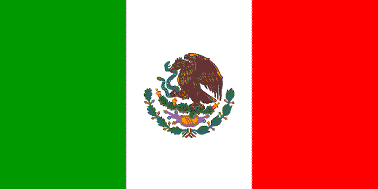
Mexico is full of Ms. Here is my tale.
The Districto Federal suffered a crimewave after the recession of the early 1990s, and as a result, armed robberies are up. Way up. In the Polanco district where I stayed with my friend, I saw high walls, high iron fences, and sometimes razor ribbon on top. When monies are collected in the subways, armed guards with rifles are there. Banks have armed guards on duty during business hours, and sometimes even at the all-night ATMs (cajera automatica).
The Lonely Planet guide to Mexico City says that Mexico is the "most heterosexual country in the world." Well, I didn't go out of my way to find the gay bookstore or any bars, but just walking around the street, nothin'. No sideways glances. No outright stares. Nothing was happening. I ought to have brought a map that featured the closets and speakeasies, I guess.
Mexico City does have a lot of sports fans, and sports magazines, and sports programming on TV. Ay!
The only gift I bought for anyone, and the only think that was asked of me, was some sort of souvenir involving Our Lady of Guadalupe. Apparently, the first "bonafide" vision in the New World was in the 1530s, when the Virgin Mary appeared to some campesinos (peasants). So I got Mary Ann, from work, a little round metal canister with guadalupe on the cover and a rosary inside. Just $3 (30 pesos).
I fell asleep as soon as I got to the hotel where I spent my first night in Mexico. The maid slipped in and out with more towels, and I never noticed.
My pal is quite the bachelor. He has a maid come in weekly to do the washing up, the laundry, the sweeping, etc. He's the only person I know, actually, who has a maid.
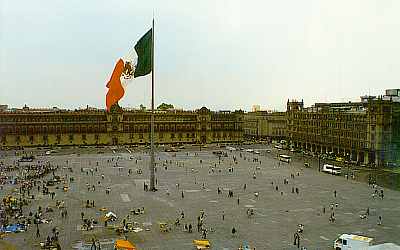
Well, I don't drink, but my friend does. We took my editor's advice and went to the rooftop restaurant at the Majestic Hotel, which overlooks el Zocalo, the historical and political center of the city. The massive, and sinking, Cathedral Metropolitana, is on the north end of the plaza, built on the site of the Aztec capital's main sacrificial temple. More than 130,000 skulls of sacrificial victims were found there when Cortes started building the Cathedral. Undoubtedly, this was as good a spot as any for persecuting heretics and lighting up the skies of the New World with auto da fes (burning the heretics).
Indigenous folks don feathers and do tribal dances. Don't get too absorbed and forget about the omnipresent pickpockets, though. All this with the Palacio Nacional, where the Presidente works, overlooking the square.
A giant flag pole with a flag bigger than any you've ever scene presiding over an auto dealership dominates the scene. I highly recommend a few hours at the Majestic. The all-you-can-consume buffet is rather good, two. Try the green rice.
Not too far from el Zocalo is Garibaldi, a big open area full of mariachi bands. I am told that when you break up with a woman, you run down here and take up mariachi. People hire bands to play at their houses. Walking through here you will be asked to hire a band, or maybe just pay them on the spot for a song. They wear traditional mariachi outfits: black pants with big silvers buttons running the length of the leg.
Hey, it's a look that's been working for them for centuries. Who am I in my Eddie Bauer knits to judge?
There are tons of ads everywhere in the D.F. considering the poverty is knee-deep (you practically soak in it), there are many ads for luxury items and Internet sites. You also notice that the people in the ads and on TV and on magazine covers look a lot more European than the average Mexican you see on the streets. My pal says racism is pretty rampant there. Well, not rampant but engrained.
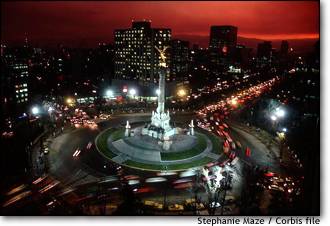
Adding to the widening gap between rich and poor is the merchandising that's everywhere. (Mexico City is a Pepsi town, for example.) Giant billboards show Internet services that surely much of the population find bewildering. Considering the high illiteracy rate (20%), you have to wonder who exactly gets Internet access. Technically, the Web is something that widens access, but for whom, really?
I only watched television the first day, at the hotel. Boy, there's some crazy crap on the tube down there. Amazingly bad stuff, including a character running around in tights and a pair of antennae on his head. Not too far off from the bumble bee on Channel Ocho on The Simpsons. Lot of odd game shows with screaming, busty hosts, and really horrible sketch "comedies." One involved a Japanese costume story and a very annoying gong.
My good friend, Marwaan, hosted me in his spacious flat. A two-bedroom, two-bathroom, two-balcony flat. I, meanwhile, live in a (relative) box in NYC. It seems you can live better any place that is not New York. We are both nocturnes and often didn't leave the house until after noon. People eat lunch late in Mexico, like 3 or 4 pm, and dinner is at 10 pm or later. That's my basic speed. Marwaan and I are good vacation companions.
I only went into two cathedrals. The one at el Zocalo and the other in Coyoacan. Unlike other cathedrals I have been to in the United States, France, England, Scotland. and Italy, people were praying like crazy there. Lots of side shrines and statues of saints lying in state in glass coffins covered with flowers. Many more people there for prayer than tourism. I felt like I was intruding. I am no fan of the Catholic Church, but I try to be respectful.
The subway is massive, meaning, incredible. I was lucky to avoid the rush hours, mostly, but some stations were clearly ready for the masses. The stations have an interesting mixture of subway systems I have seen elsewhere, but not New York's. The cars are red-orange, and boxy. Reminiscent of the Parisian subway cars, but much more quadrangular. Like biscuit tins on rubber wheels (also Parisian).
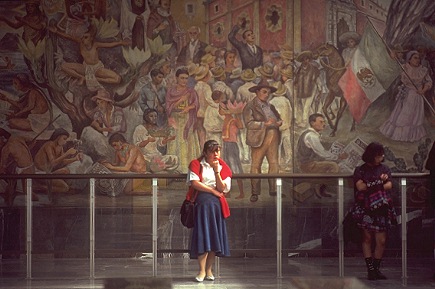
The stations themselves have a marble-looking floortile that evokes a more ancient, pre-Columbian time. The trackbeds are lower than they are in New York, reminiscent of Montreal's stations. Unlike London and Paris, the stations do not have curved ceilings. They have a more open feel, like Montreal's.
Inside the cars, the strip maps emphasize each station's icon more than the name. More than 20 percent of the population is illiterate. That is the only part that resembled New York, where some of the older stations' tilework and mosaics were pictograms for those who don't know English.
And you know, it's only about 20 cents for a Metro ticket. Just buy plenty in advance at the taquilla (ticket window).
It is not easy finding things in Mexico City. Marwaan says that you have to ask three people for directions in the D.F. Crealo! (Believe it!) I circumnavigated the entire Museo Nacional de Anthropologia before finding the entrance. It's only the biggest museum they have. You think there might be a friggin' sign when you get out of the Metro. No. Same problem trying to find the subway going home. Luckily, I was in no hurry, and ambled along amicably.
Because of the predominance of a laid-back culture, finding dinner at midnight is no problem. We dined at that hour, and there were plenty of other folks out.
I had not seen Abdul (Marwaan) for six years, and we have known each other for 17, so we went through a list of approximately 50 or so people to figure out what became of everyone. Ask me to tell you the story about my dorm-room carpet sometime.

In all the reading I did, I was half expecting the pollution to bring birds out of the skies and armed robberies at every corner. My friend Joe told me, "Just be cautious like you are in New York, but six or seven times more so." It worked. Avoiding hailing cabs on the street is a good idea, as some people wind up "kidnapped" for a few hours as your driving escorts you from one ATM to another.
The more reputable cabbies are the ones you hire from taxi stands. There is a little more accountability. The green-and-white VM Beetles are the more dangerous variety. At the airport, take the yellow-and-white cabs into town for about $10 (109 pesos).
Right of el Zocalo is a big market on the weekends. Avoid it. It's crowded and dangerous and the hands you feel in your pocket are not your own.
When the Conquistadores came to Mexico in the 15th Century, they wiped out only the culture, not all the people. Intermarriage, or at least intermingling, led to mestizos--people who are part European and part indigenous Indians. One thing that is instantly noticeable when you go to Mexico City is the great multitude of faces. So many different kinds of people.
From tall and slender to shorter and stouter, the city is quite naturally diverse. It's not like New York, where you see a lot of black faces, Southeast Asians, Chinese, etc., but it's still very noticeable. Unfortunately, you do not see that diversity on Mexican television or advertising, which tends to continue to hold up the Eurobeauty ideal.
I visited Mexico City in June, but it was quite chilly--about 70 degrees Fahrenheit daily. Mexico City is 7400 feet above sea level, so of course it's colder than the usual city in summertime. Every night at 8 pm there seemed to be cloudbursts, just like clockwork. The rains helped the air quality. The first day I was there, I could see and tasted the pollution, and the smog and elevation knocked me out for the first day I was there.
This is a necessity, and luckily, you can find it everywhere. Pen––afiel seems to be a favorite brand.
Little buses feed the Metro, and they are also quite cheap, about 15 cents. None of the microbuses have been cleaned, ever, it seems.
For all the history and bad blood the Mexicans have for America, it's confusing to see the dollar sign being used to indicate prices in pesos. Things are insanely cheap in Mexico City. A generous dinner for two only cost US$24. I only took US$200 in pesos with me, and still had some left at the end. I did use my Visa card, but not all that much or for too much.
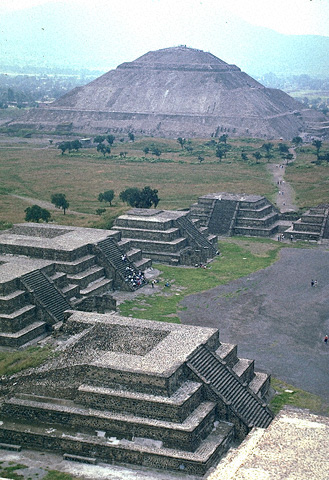
The Aztecs and Moctezuma are long gone, but the city has some phenomenal, heavy structures, and seems full of monuments. The Auditorio Nacional resembles a giant boulder. When you go to the Museo Nacional de Anthropologia, twin brick-brown condos hover over the trees in the distance. The Paseo de la Reforma, the grandest of roads in the city, features monuments along the way (like the Angel), and the road itself feels like a monument. The fantastic architecture abets the notion that some parts of the city are museums in their own right.
A trip on the last full day of my vacation, to Teotichuan, showed this history. The ruins of a grand boulevard, with the Piramides in the distance, show this history of big heavy structures. Marwaan and I climbed to the top of the Piramide del Sol. In the distance we could see a sheet of rain pouring from a cloud and heading our way. The base of this pyramid is as big as the ones in Egypt, but I don't think it was a tall as the ones in Egypt.
Climbing a pyramid from the year 100 also showed me how out of shape I am!
Mexico City is in a valley, and ringed by mountains. Before 1940 one could actually see them, but the thermal inversion and pollution have blocked the vistas. I only saw them from the roof of the Majestic on a clearer day.
Marwaan and I went to two movies. First, the horrible I Dreamed of Africa, and then The Whole Nine Yards. It's difficult listening to a movie in English and reading Spanish subtitles. I found myself comparing the real dialogue to the translation. Since I took seven years of Spanish, it was interesting to see the idioms and the cultural biases. The theatre we went to in Polanco was big and new and part of a mall. It seemed fairly state of the art, comparable to a mall movie theatre in an American suburb.
There are plenty of cars and cabs in the Big M, as Marwaan calls it. The small green-and-white cabs, many of which are VM bugs with the front passenger seat removed, are everywhere. Don't take them unless you get them from a taxi stand. There's a certain element of accountability that way.
People are manic drivers and I was nearly killed twice. First on my last night there. Marwaan and I were in a cab that hit a truck, and almost got squashed between two trucks, one of them a petrol tanker. My cab driver to the aeropuerto nearly got us killed "playing checkers" on the highways, cutting off cars like it was going out of style. Then he "had no change" and I wound up spending twice as much on my final cab ride.
On an very extended bus ride from Coayocan to a the Universidad metro station, we saw of poverty. A lot of stray dogs and dirt roads. Mexico City has plenty of beggars. You see people begging in every metro station, with their filth-covered children sleeping on the marblesque floors. Marwaan says that Mexico does not have a tradition of charity organizations as we do in America.
Perhaps because the Catholic Church used to provide a lot of charitable work, but there's so much misery no one group could do it all. Widespead corruption and the country being dominated, until recently, by one political party since 1917, certainly could not have helped. The recession of the 1990s widened the gap, which is why there are machine guns all over the better neighborhoods.
What Mexico lacks in spirituality when it comes to taking care of its own is somewhat made up for in the omnipresent art and color. Even in the poorest neighborhoods, there are houses in bright, light colors, and a lot of murals too. Muralla is the Spanish word for mural. The mural as artform is wonderfully shown in the Palacio de Bellas Artes, an ornate affair with an art deco interior. The four-storey entry area, before the theatre, features many murals, and rooms for other exhibits of photography and sculpture by Mexican artists.
Of all the works there, however, the most impressive is Diego Rivera's *Man at the Crossroads Looking with Hope and High Vision to the Choosing of a New and Better Future*. This is the mural that Nelson Rockefeller, who commissioned Rivera to paint it for his Rockefeller Center lobby in 1934, had destroyed. It was recommissioned for consumption in Mexico, and was completed in 1938. It shows Marx, forces against fascism, and syphyllis germs hovering over rich flappers sipping champagne. It's really a masterpiece, both up close and even across the atrium, or even across the atrium and from a higher floor. But you don't have to go to Bellas Artes to see art. Wherever there's a wall in Mexico, there seems to be art. Every Metro station has something unique going on to lift up commuters' spirits.
While there are many museums in Mexico City, I only went to three. First, the Museo Nacional de Anthropologia. This massive rectangular structure seems typical of the ultramodern clean designs of 1964, when it was built. A giant tree-like structure graces the interior court, and it was hard not to marvel at it. The museum traces the lost pre-Columbian cultures of Mexico. The Ohmecs, the Maya, the Toltecs, the Aztecs. Everything from pottery to big ugly heads weighing several tons are catalogued here. Some things are in English and some are not, so be warned.
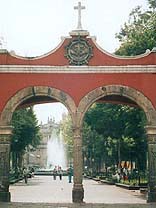

On Saturday, Marwaan and I went to Coyoacan and visited two museums. First, the home of Frida Kahlo, which is surrounded by a big blue wall that encloses the home and the garden. This is where she lived with Diego Rivera. Their names grace the wildly decorated kitchen walls. It's an old home, without the modern conveniences, except perhaps electricity and a radio. The stove is a long surface along one wall, with great ceramic pots on top of holes where fires lit them from underneath. No gas or electric stoves here.
This was similar to the home of Leon Trotsky, which is not too far from Kahlo's house. The former leading figure of the Soviet Union spend his exile here, until his death by ice-pick. His home is a collection of buildings and a large garden, where he is buried under a granite block that sports a large hammer-and-sickle under a palm plant. Also surviving is Trotsky's chicken coops and rabbit hutch. You would never know this green pastel-walled complex was home to a real revolutionary.
A big cultural difference between America Latina and el Norte is music, and the relationship people have to music. There seems to be music playing somewhere, everywhere, when you're down there. On my first night in Mexico City, Marwaan took me to a restaurant that featured live music, and tapes when the performers were on breaks. The two young couples at the table nearby broke out into spontaneous singing several times. I thought it rather charming and I thought it was a sign of happiness. I don't think a sad, depressed people burst out in to song in public. Do you?
For a look at my second trip to Mexico (in May 2001), click here.
Next Entry... Bookey Goes to Beantown
Previous Entry... "Puck"